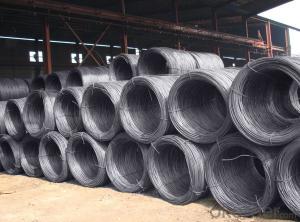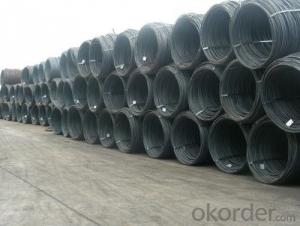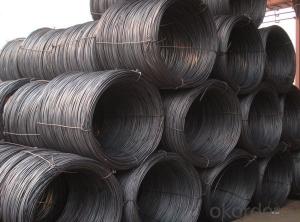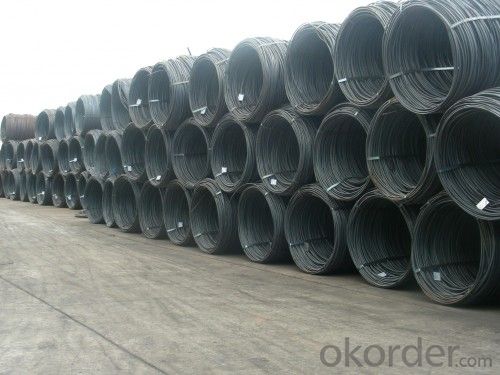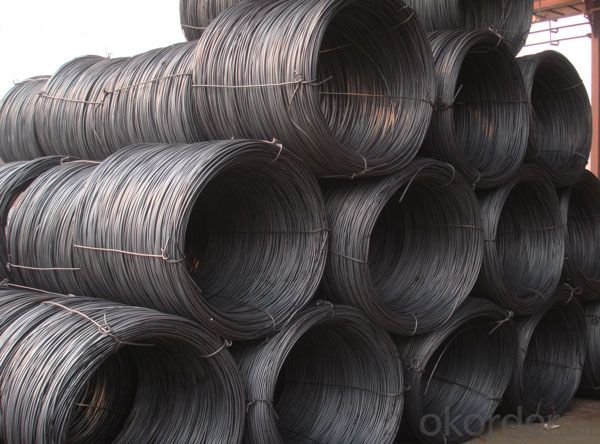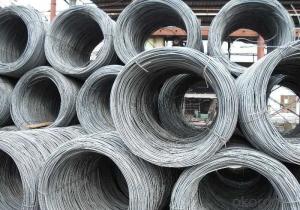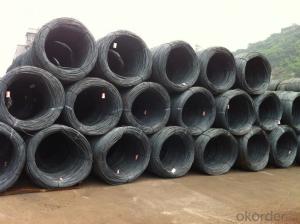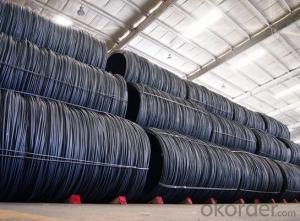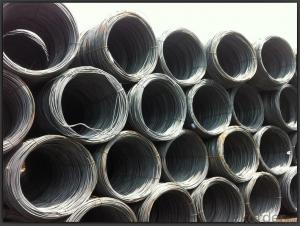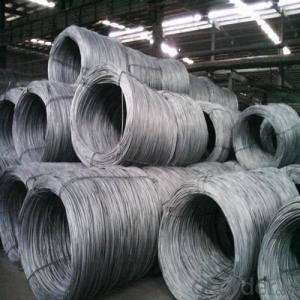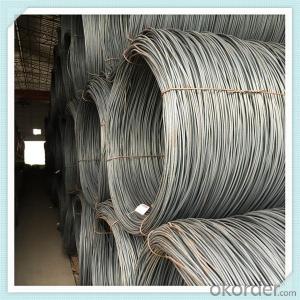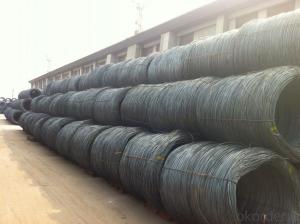Wire Rod High Quality Hot Rolled SAE1008 SAE1006
- Loading Port:
- Tianjin
- Payment Terms:
- TT OR LC
- Min Order Qty:
- 25 m.t.
- Supply Capability:
- 2000000 m.t./month
OKorder Service Pledge
OKorder Financial Service
You Might Also Like
Specification
Product Description:
OKorder is offering Wire Rod High Quality Hot Rolled SAE1008 SAE1006 at great prices with worldwide shipping. Our supplier is a world-class manufacturer of steel, with our products utilized the world over. OKorder annually supplies products to European, North American and Asian markets. We provide quotations within 24 hours of receiving an inquiry and guarantee competitive prices.
Product Applications:
Wire Rod High Quality Hot Rolled SAE1008 SAE1006 shaped into coil and delivery as finished product, including round, square, rectangular, hexagonal and so on. Since most of the products are round, it is generally called wire rod. Carbon steel wire rod is widely used in construction and manufacturing. Carbon steel wire rod is mainly used for reinforcement of reinforced concrete and welded structure or reprocessed (roberts , nail, etc.) materials, especially used to produce wire drawing, welding electrode, nails, spring, electronic, precise machinery parts and so on.
Product Advantages:
Wire Rod High Quality Hot Rolled SAE1008 SAE1006 are durable, strong, and resist corrosion.
Main Product Features:
· Premium quality
· Prompt delivery & seaworthy packing (30 days after receiving deposit)
· Corrosion resistance
· Can be recycled and reused
· Mill test certification
· Professional Service
· Competitive pricing
Product Specifications:
Manufacture: Hot rolled
Grade: SAE1008 SAE 1006
Certificates: ISO, SGS, BV, CIQ
Diameter: 5.5mm, 6.5mm, 7mm,8mm,9mm,10mm,12mm,14mm, as per customer request
Packaging: Export packing, nude packing, bundled
Grade | Chemical Composition (%) | |||||
C | Mn | S | P | Si | B | |
SAE1008B | 0.10max | 0.32max | 0.045max | 0.040max | 0.30max | 0.0008min |
Mechanical properties | ||||||
Yield strength(N/mm2) | Tensile strength(N/mm2) | Elongation (%) | ||||
≥195 | 350-380 | ≥32 | ||||
FAQ:
Q1: Why buy Materials & Equipment from OKorder.com?
A1: All products offered byOKorder.com are carefully selected from China's most reliable manufacturing enterprises. Through its ISO certifications, OKorder.com adheres to the highest standards and a commitment to supply chain safety and customer satisfaction.
Q2: How do we guarantee the quality of our products?
A2: We have established an advanced quality management system which conducts strict quality tests at every step, from raw materials to the final product. At the same time, we provide extensive follow-up service assurances as required.
Q3: How soon can we receive the product after purchase?
A3: Within three days of placing an order, we will begin production. The specific shipping date is dependent upon international and government factors, but is typically 7 to 10 workdays.
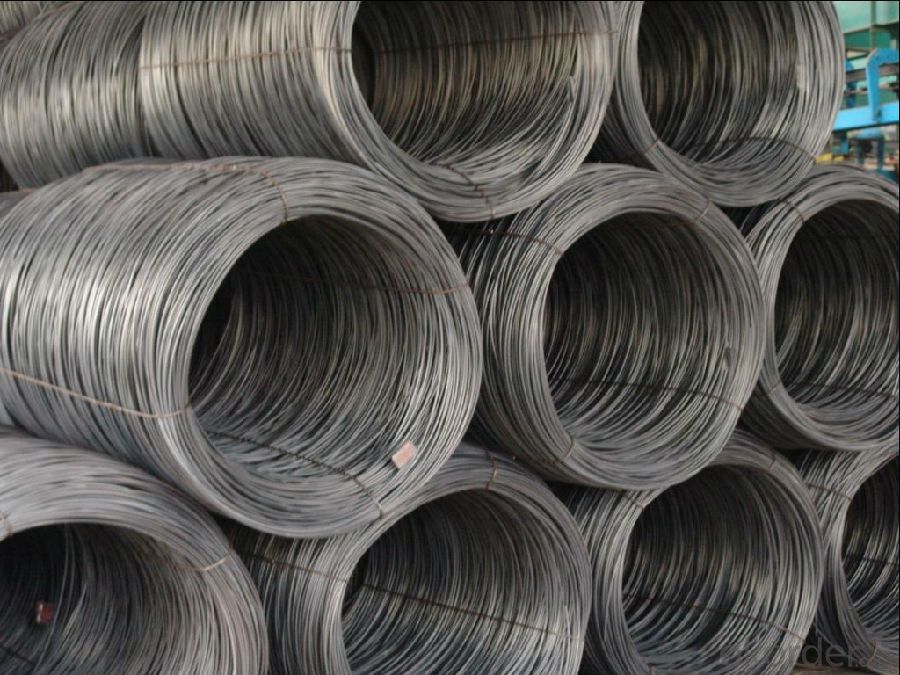
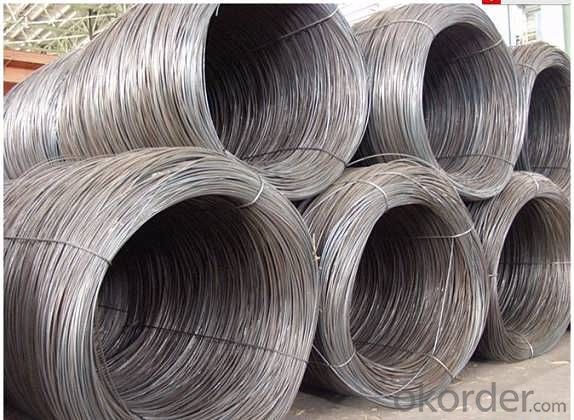
- Q: What are the different types of steel wire rod coatings used for improved machinability?
- There are several different types of steel wire rod coatings that can be used to improve machinability. These coatings are designed to reduce friction and heat during the machining process, which helps to improve tool life and increase productivity. One common type of coating used for improved machinability is a titanium nitride (TiN) coating. TiN coatings provide a hard, wear-resistant surface that reduces friction and heat buildup, resulting in improved tool life and increased cutting speeds. Additionally, TiN coatings can help prevent built-up edge formation and improve chip flow, further enhancing machinability. Another type of coating used for improved machinability is a titanium carbonitride (TiCN) coating. TiCN coatings have similar properties to TiN coatings, but they offer higher hardness and improved resistance to abrasive wear. This makes TiCN-coated wire rods particularly suitable for machining hard materials or in applications with high cutting speeds. Diamond-like carbon (DLC) coatings are also used for improved machinability. DLC coatings provide a low coefficient of friction, excellent hardness, and good thermal stability. These properties make DLC-coated wire rods ideal for high-speed machining operations, as they reduce friction and heat generation. Other commonly used coatings for improved machinability include aluminum titanium nitride (AlTiN) and zirconium nitride (ZrN) coatings. AlTiN coatings offer high hardness, excellent oxidation resistance, and low friction, making them well-suited for machining stainless steels and other difficult-to-machine materials. ZrN coatings provide good hardness and wear resistance, along with low friction, making them suitable for various machining applications. In conclusion, the different types of steel wire rod coatings used for improved machinability include titanium nitride (TiN), titanium carbonitride (TiCN), diamond-like carbon (DLC), aluminum titanium nitride (AlTiN), and zirconium nitride (ZrN) coatings. Each of these coatings offers specific advantages and is chosen based on the specific machining requirements and material being worked on.
- Q: How are steel wire rods used in the production of wire springs?
- Wire springs rely heavily on steel wire rods, which are melted and shaped into cylindrical forms through rolling. The resulting rods are then drawn through dies to decrease their diameter and increase their length, imparting strength and flexibility. This process ensures the suitability of the wire rods for spring usage. After the drawing process, the steel wire rods are commonly coiled onto large spools or reels. These coiled wires are then fed into machines that manufacture springs. The wire is cut to the desired length and shaped into different spring forms, such as helical coils or conical shapes. The inherent strength and elasticity of steel wire rods make them highly suitable for wire springs. These springs find extensive applications in various industries, including automotive suspensions, furniture, industrial machinery, and household appliances. The steel wire rods provide the necessary tensile strength and resilience to endure the forces and stresses experienced in these applications. To sum up, steel wire rods play a crucial role in the production of wire springs, providing the strength, flexibility, and resilience required for effective functioning in diverse industries and applications.
- Q: How does the fatigue strength of steel wire rod vary with different heat treatment processes?
- The fatigue strength of steel wire rod can vary significantly depending on the methods of heat treatment employed. Heat treatment involves subjecting the steel wire rod to specific heating and cooling processes in order to change its microstructure and mechanical properties. One commonly used heat treatment process to improve the fatigue strength of steel wire rod is quenching and tempering. This process includes heating the wire rod to a high temperature and then rapidly cooling it (quenching) to achieve a hardened microstructure. This leads to an increase in the fatigue strength of the wire rod because the hardened structure provides better resistance against fatigue failure. The subsequent tempering process involves reheating the wire rod to a lower temperature and slowly cooling it, which helps to relieve internal stresses and improve the toughness of the wire rod while maintaining an optimum balance of strength and ductility. On the other hand, if the steel wire rod undergoes a heat treatment process at a lower temperature, such as annealing, the fatigue strength may be reduced. Annealing involves heating the wire rod to a specific temperature and allowing it to cool slowly, often in a controlled atmosphere. This process is used to soften the wire rod, relieve internal stresses, and improve its machinability and formability. However, the resulting softer microstructure may cause a decrease in fatigue strength compared to quenched and tempered wire rod. In conclusion, the fatigue strength of steel wire rod can be improved through heat treatment processes like quenching and tempering, which lead to a hardened microstructure. Conversely, heat treatment processes like annealing can decrease the fatigue strength by producing a softer microstructure. Therefore, the selection of heat treatment processes is crucial in determining the fatigue strength of steel wire rod.
- Q: What are the different corrosion protection methods for steel wire rod?
- There are several corrosion protection methods for steel wire rods, including galvanization, coating with paint or epoxy, electroplating, and using corrosion inhibitors. Each method provides a barrier between the steel wire rod and the corrosive environment, preventing or slowing down the corrosion process.
- Q: How is steel wire rod used in the manufacturing of wire harnesses?
- Steel wire rod is used in the manufacturing of wire harnesses as it serves as the core material for the wires. The wire rod is first drawn into the desired diameter and then further processed to form the individual wires. These wires are then bundled together and insulated to create the wire harnesses, which are essential components in electrical systems used in various industries such as automotive, aerospace, and electronics. The strength and durability of steel wire rod make it an ideal choice for ensuring the reliability and longevity of wire harnesses.
- Q: How is steel wire rod used in the manufacturing of wire forms for display racks?
- Steel wire rod is a crucial component in the manufacturing of wire forms for display racks. It is used as the raw material that undergoes various manufacturing processes to create wire forms with specific shapes and sizes. The first step in the process involves selecting the appropriate quality and diameter of steel wire rod. The selection depends on the desired strength, durability, and flexibility of the wire forms. Once the suitable steel wire rod is chosen, it is fed into a wire drawing machine, where it is pulled through a series of dies to reduce its diameter and increase its length. After the wire has been drawn to the desired size, it goes through a series of shaping and bending processes. This can include using specialized machines or tools to bend the wire into specific angles, curves, or shapes required for the display racks. The wire may also be cut into specific lengths as per the design requirements. To ensure the wire forms maintain their shape and structure, they may undergo further processes such as heat treatment or galvanization. Heat treatment strengthens the wire forms, making them more resistant to bending or deforming under heavy loads. Galvanization involves coating the wire forms with a layer of zinc to protect them from corrosion, increasing their lifespan. Once the wire forms are shaped, bent, and treated, they are ready to be assembled into the display racks. These wire forms can be used for various purposes in the display rack industry, such as creating shelves, hooks, or frames. The versatility of steel wire rod allows for the production of wire forms with different designs, sizes, and load capacities to meet the specific requirements of the display rack applications. In summary, steel wire rod is a crucial material in the manufacturing of wire forms for display racks. It undergoes various processes such as wire drawing, shaping, bending, and treatment to create wire forms with specific shapes, sizes, strength, and durability. These wire forms are then assembled into display racks, providing a sturdy and versatile solution for showcasing products.
- Q: How is steel wire rod used in the production of wire strands for electrical transmission lines?
- Steel wire rod is used in the production of wire strands for electrical transmission lines by being stretched, twisted, and coated with protective layers to form strong and durable wire strands. These wire strands are then bundled together to create the conductive core of the transmission line, which carries electricity over long distances with minimal energy loss.
- Q: What are the main factors affecting the market policies of steel wire rod?
- The main factors affecting market policies of steel wire rod include supply and demand dynamics, global economic conditions, trade policies and regulations, technological advancements, pricing trends, and competition within the industry. Additionally, factors such as raw material availability, environmental regulations, and government policies related to infrastructure development and manufacturing also play a significant role in shaping market policies for steel wire rod.
- Q: What are the different surface defects that can affect the ductility of steel wire rod?
- Some of the different surface defects that can affect the ductility of steel wire rod include cracks, surface roughness, scale, pitting, and surface decarburization. These defects can weaken the material and reduce its ability to stretch or deform without breaking.
- Q: What are the different types of steel wire rod surface defects?
- There are several types of steel wire rod surface defects, including scale, pitting, scratches, cracks, and rust. Scale refers to the buildup of oxide layers on the surface, which can affect the wire's quality. Pitting is the formation of small depressions or pits on the surface, often caused by corrosion. Scratches are visible marks or lines on the surface, which can occur during handling or processing. Cracks are fractures in the wire rod surface, which can weaken its strength. Rust is the formation of iron oxide on the surface due to exposure to moisture or corrosive substances.
Send your message to us
Wire Rod High Quality Hot Rolled SAE1008 SAE1006
- Loading Port:
- Tianjin
- Payment Terms:
- TT OR LC
- Min Order Qty:
- 25 m.t.
- Supply Capability:
- 2000000 m.t./month
OKorder Service Pledge
OKorder Financial Service
Similar products
Hot products
Hot Searches
Related keywords
